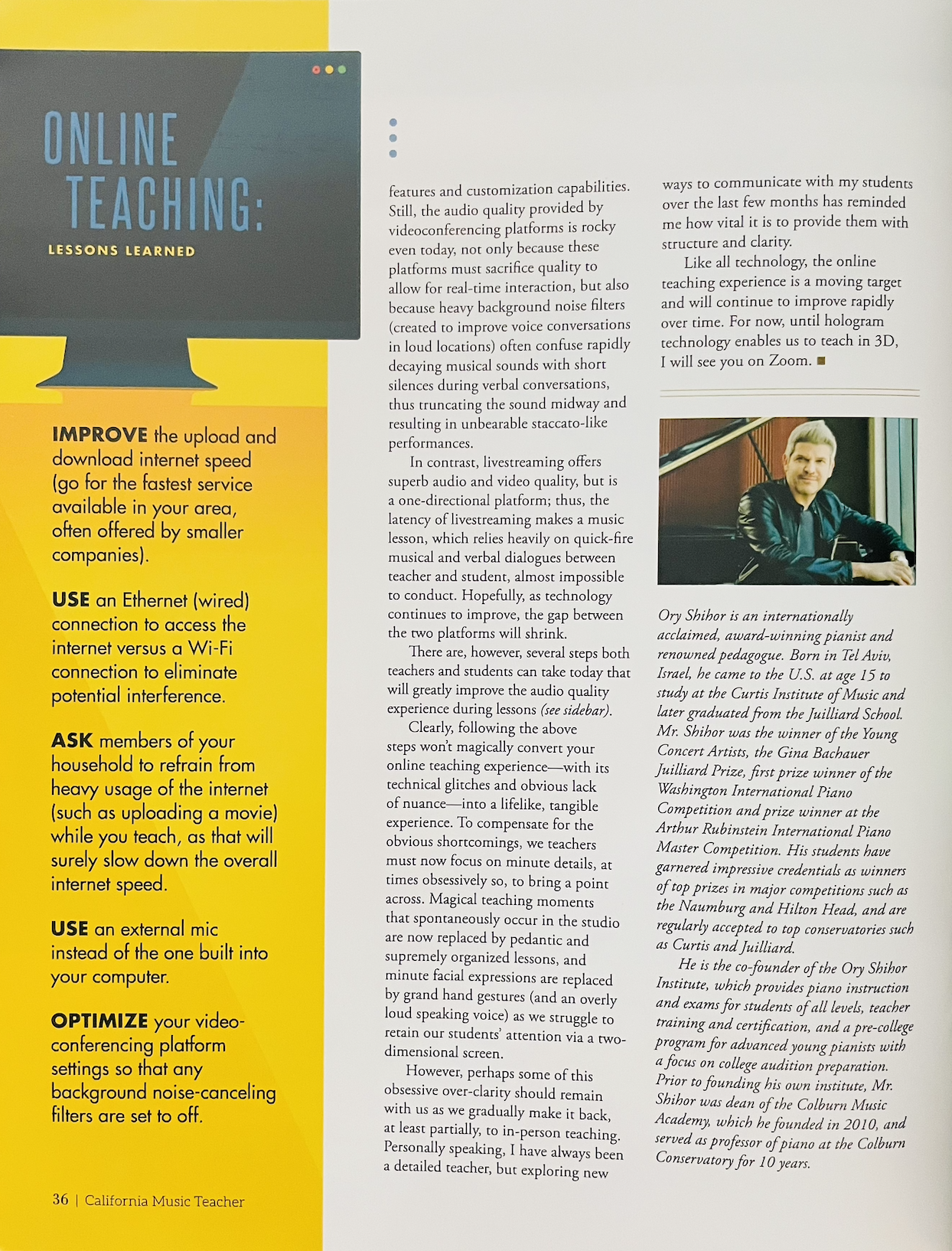Featured Article in CMT: Online Teaching - Lessons Learned
Written by Ory Shihor
This feature article was originally published in the California Music Teacher magazine
Volume 44 | Number 2 | Fall 2020
Printed Publication
Online Teaching: Lessons Learned
Written by Ory Shihor
This feature article was originally published in the California Music Teacher magazine
Volume 44 | Number 2 | Fall 2020
Prior to 2014, the world of remote learning was totally unfamiliar to me, except for taking a lesson from my teacher once over the telephone when I was 13. I would hear about online teaching sporadically from other teachers, who made it sound exciting. “I have to wake up at 3 a.m. tomorrow to teach my Chinese students,” my violin teacher friend proudly announced.
I tried to imagine what it must be like to hear a student play Bach at 4 a.m. with phone-like sound quality. Not for me, I thought. Then one day a student from the East Coast asked me if I would teach her online, and then another one from the Bay Area, and one more from LA’s Westside, whose parents refused to drive to anywhere east of the 405 Freeway (it’s an LA thing) and downtown LA, where my studio is located, was particularly forbidden.
And that’s how my odyssey into remote teaching began.
At first, I went with a hardware-based videoconferencing system, which offered a decent sound quality but was highly unreliable and very expensive. Gradually, as the sound quality over online videoconferencing platforms improved, I abandoned my old hardware-based system and settled on Zoom as my platform of choice due to its many features and customization capabilities.
Still, the audio quality provided by videoconferencing platforms is rocky even today, not only because these platforms must sacrifice quality to allow for real-time interaction, but also because heavy background noise filters (created to improve voice conversations in loud locations) often confuse rapidly decaying musical sounds with short silences during verbal conversations, thus truncating the sound midway and resulting in unbearable staccato-like performances.
In contrast, livestreaming offers superb audio and video quality but is a one-directional platform; thus the latency of livestreaming makes a music lesson, which relies heavily on quick-fire musical and verbal dialogues between teacher and student, almost impossible to conduct. Hopefully, as technology continues to improve, the gap between the two platforms will shrink.
There are, however, several steps both teachers and students can take today that will greatly improve their audio quality experience during lessons:
Improve the upload and download Internet speed (go for the fastest service available in your area, often offered by smaller companies).
Use an Ethernet (wired) connection to access the Internet versus a Wi-Fi connection in order to eliminate potential interference.
Ask members of your household to refrain from heavy usage of the Internet (such as uploading a movie) while you teach, since that will surely slow down the overall Internet speed.
Use an external mic instead of the one built into your computer.
Optimize your videoconferencing platform settings so that any background noise-canceling filters are set to off.
Clearly, following the above steps won’t magically convert your online teaching experience, with its technical glitches and obvious lack of nuance, into a lifelike, tangible experience. In order to compensate for the obvious shortcomings, we teachers must now focus on minute details, at times obsessively so, in order to bring a point across.
Magical teaching moments that spontaneously occur in the studio are now replaced by pedantic and supremely organized lessons, and minute facial expressions are replaced by grand hand gestures (and an overly loud speaking voice) as we struggle to retain our students’ attention via a two-dimensional 8 x 11 screen.
However, perhaps some of this obsessive over-clarity should remain with us as we gradually make it back, at least partially, to in-person teaching. Personally speaking, I have always been a detailed teacher, but exploring new ways to communicate with my students over the last few months has reminded me how vital it is to provide students with structure and clarity.
Like all technology, the online teaching experience is a moving target and will continue to improve rapidly over time. For now, until hologram technology enables us to teach in 3D, I will see you on Zoom.





